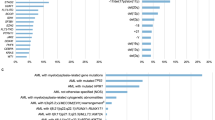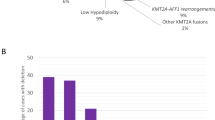Abstract
Few large demographic studies of acute myeloid leukemia (AML) are derived from population-based registries. Demographic and karyotypic data were provided for AML cases from two regional leukemia registry databases in Scotland and the Northern Region of England. A population-based dataset was compiled, comprising 1709 patients aged >16 years (1235 North England/474 Scotland patients). The most common cytogenetic abnormalities involved chromosomes 5 and/or 7 (17%). Patients with the following abnormal chromosome 5/7 combinations: −5, del(5q), −5/−7 and del(5q)/−7 represented a significantly older population (P<0.01, ANOVA). t(8;21) was the only ‘favourable’ karyotype found in older age. Karyotypic complexity varied within chromosome 5/7 combination groups; those containing −5, −5/−7, −5/del(7q), del(5q)/−7 or del(5q)/del(7q) combinations were significantly more frequently complex than those containing −7 and del(7q) (P<0.01, χ2 test). Additional recurring cytogenetic abnormalities within complex karyotypes containing chromosome 5/7 combinations included (in order of frequency), abnormalities of chromosomes 17, 12, 3 and 18. Complex karyotypes not involving chromosomes 5 or 7 represented 30% of all complex karyotypes, occurred in younger patients than those involving chromosomes 5 and 7, and frequently included additional trisomy 8 (26%). In conclusion, we describe subgroups within adverse karyotypes, with different demographics, degree of complexity and additional chromosome abnormalities.
This is a preview of subscription content, access via your institution
Access options
Subscribe to this journal
Receive 12 print issues and online access
$259.00 per year
only $21.58 per issue
Buy this article
- Purchase on Springer Link
- Instant access to full article PDF
Prices may be subject to local taxes which are calculated during checkout


Similar content being viewed by others
References
Bennett JM, Catovsky D, Daniel MT, Flandrin G, Galton DA, Gralnick HR et al. Proposals for the classification of the acute leukaemias. French-American-British (FAB) co-operative group. Br J Haematol 1976; 33: 451–458.
Bennett JM . World Health Organization classification of the acute leukemias and myelodysplastic syndrome. Int J Hematol 2000; 72: 131–133.
Rowley JD, Golomb HM . The 4th International Workshop on chromosomes in leukemia – a prospective study of acute non-lymphocytic leukemia, Chicago, Illinois, USA, September 2–7 1982. Cancer Genetics And Cytogenetics 1984; 11: 249.
Bloomfield CD, Shuma C, Regal L, Philip PP, Hossfeld DK, Hagemeijer AM et al. Long-term survival of patients with acute myeloid leukemia: a third follow-up of the Fourth International Workshop on Chromosomes in Leukemia. Cancer 1997; 80 (11 Suppl): 2191–2198.
Grimwade D, Walker H, Oliver F, Wheatley K, Harrison C, Harrison G et al. The importance of diagnostic cytogenetics on outcome in AML: analysis of 1,612 patients entered into the MRC AML 10 trial. The Medical Research Council Adult and Children's Leukaemia Working Parties. Blood 1998; 92: 2322–2333.
Wheatley K, Burnett AK, Goldstone AH, Gray RG, Hann IM, Harrison CJ et al. A simple, robust, validated and highly predictive index for the determination of risk-directed therapy in acute myeloid leukaemia derived from the MRC AML 10 trial. United Kingdom Medical Research Council's Adult and Childhood Leukaemia Working Parties. Br J Haematol 1999; 107: 69–79.
Taylor PR, Reid MM, Stark AN, Bown N, Hamilton PJ, Proctor SJ . De novo acute myeloid leukaemia in patients over 55-years-old: a population-based study of incidence, treatment and outcome. Northern Region Haematology Group. Leukemia 1995; 9: 231–237.
Proctor SJ, Taylor PR . Age cohort subgroups in adult acute myeloid leukaemia studies – the population perspective. Leukemia 2001; 15: 188–189.
Preiss BS, Kerndrup GB, Schmidt KG, Sorensen AG, Clausen NA, Gadeberg OV et al. Cytogenetic findings in adult de novo acute myeloid leukaemia. A population-based study of 303/337 patients. Br J Haematol 2003; 123: 219–234.
Mitelman F . ISCN: An international system for human cytogenetic nomenclature. Basel, Switzerland: Karger, 1995.
Moorman AV, Roman E, Willett EV, Dovey GJ, Cartwright RA, Morgan GJ et al. Karyotype and age in acute myeloid leukemia Are they linked? Cancer Genet Cytogenet 2001; 126: 155–161.
Schoch C, Kern W, Krawitz P, Dugas M, Schnittger S, Haferlach T et al. Dependence of age-specific incidence of acute myeloid leukemia on karyotype. Blood 2001; 98: 3500.
Mauritzson N, Johansson B, Albin M, Billstrom R, Ahlgren T, Mikoczy Z et al. A single-center population-based consecutive series of 1500 cytogenetically investigated adult hematological malignancies: karyotypic features in relation to morphology, age and gender. Eur J Haematol 1999; 62: 95–102.
Moorman AV, Roman E, Cartwright RA, Morgan GJ . Patients entered into MRC AML trials are biologically representative of the totality of the disease in the UK. Clin Lab Haematol 2002; 24: 263–265.
Moorman AV, Roman E, Cartwright RA, Morgan GJ . Age-specific incidence rates for cytogenetically-defined subtypes of acute myeloid leukaemia. Br J Cancer 2002; 86: 1061–1063.
Vickers M, Jackson G, Taylor P . The incidence of acute promyelocytic leukemia appears constant over most of a human lifespan, implying only one rate limiting mutation. Leukemia 2000; 14: 722–726.
Mertens F, Johansson B, Mitelman F . Age- and gender-related heterogeneity of cancer chromosome aberrations. Cancer Genet Cytogenet 1993; 70: 6–11.
Cartwright RA, Gurney KA, Moorman AV . Sex ratios and the risks of haematological malignancies. Br J Haematol 2002; 118: 1071–1077.
Grimwade D, Walker H, Harrison G, Oliver F, Chatters S, Harrison CJ et al. The predictive value of hierarchical cytogenetic classification in older adults with acute myeloid leukemia (AML): analysis of 1065 patients entered into the United Kingdom Medical Research Council AML11 trial. Blood 2001; 98: 1312–1320.
Schoch C, Haferlach T, Bursch S, Gerstner D, Schnittger S, Dugas M et al. Loss of genetic material is more common than gain in acute myeloid leukemia with complex aberrant karyotype: a detailed analysis of 125 cases using conventional chromosome analysis and fluorescence in situ hybridization including 24-color FISH. Genes Chromosomes Cancer 2002; 35: 20–29.
Pedersen-Bjergaard J, Andersen MK, Christiansen DH, Nerlov C . Genetic pathways in therapy-related myelodysplasia and acute myeloid leukemia. Blood 2002; 99: 1909–1912.
Castro PD, Liang JC, Nagarajan L . Deletions of chromosome 5q133 and 17p loci cooperate in myeloid neoplasms. Blood 2000; 95: 2138–2143.
Van Limbergen H, Poppe B, Michaux L, Herens C, Brown J, Noens L et al. Identification of cytogenetic subclasses and recurring chromosomal aberrations in AML and MDS with complex karyotypes using M-FISH. Genes Chromosomes Cancer 2002; 33: 60–72.
Crescenzi B, Lastarza R, Romoli S, Beacci D, Matteucci C, Barba G et al. Submicroscopic deletions in 5q- associated malignancies. Haematologica 2004; 89: 281–285.
Paulsson K, Sall T, Fioretos T, Mitelman F, Johansson B . The incidence of trisomy 8 as a sole chromosomal aberration in myeloid malignancies varies in relation to gender, age, prior iatrogenic genotoxic exposure, and morphology. Cancer Genet Cytogenet 2001; 130: 160–165.
Wolman SR, Gundacker H, Appelbaum FR, Slovak ML . Impact of trisomy 8 (+8) on clinical presentation, treatment response, and survival in acute myeloid leukemia: a Southwest Oncology Group study. Blood 2002; 100: 29–35.
Schoch C, Haase D, Fonatsch C, Haferlach T, Loffler H, Schlegelberger B et al. The significance of trisomy 8 in de novo acute myeloid leukaemia: the accompanying chromosome aberrations determine the prognosis. German AML Cooperative Study Group. Br J Haematol 1997; 99: 605–611.
Nilsson L, Astrand-Grundstrom I, Anderson K, Arvidsson I, Hokland P, Bryder D et al. Involvement and functional impairment of the CD34+CD38-Thy−1+ hematopoietic stem cell pool in myelodysplastic syndromes with trisomy 8. Blood 2002; 100: 259–267.
Acknowledgements
The Hematology Units in Scotland, and the North East of England, who contributed invaluable data to the respective registries. The assistance of Christine Maguire and Jo White in the Scotland Leukaemia Registry is gratefully acknowledged. We are grateful to Dr. David Grimwade for critical review of the manuscript. PRT is supported by the Newcastle upon Tyne Hospitals Regional Research and Development Fund. The Scotland Leukaemia Registry was generously supported by a grant from the Lloyds/TSB Research Foundation.
Author information
Authors and Affiliations
Corresponding author
Rights and permissions
About this article
Cite this article
Sanderson, R., Johnson, P., Moorman, A. et al. Population-based demographic study of karyotypes in 1709 patients with adult Acute Myeloid Leukemia. Leukemia 20, 444–450 (2006). https://doi.org/10.1038/sj.leu.2404055
Received:
Revised:
Accepted:
Published:
Issue Date:
DOI: https://doi.org/10.1038/sj.leu.2404055
Keywords
This article is cited by
-
Cytogenetic profile of 1791 adult acute myeloid leukemia in India
Molecular Cytogenetics (2023)
-
Venetoclax plus hypomethylating agents in newly diagnosed acute myeloid leukemia patients with RUNX1::RUNX1T1: a retrospective propensity score matching study
Blood Cancer Journal (2023)
-
Incidence of myeloid neoplasms in Spain (2002–2013): a population-based study of the Spanish network of cancer registries
Scientific Reports (2022)
-
Incidence and prognostic significance of karyotypic subgroups in older patients with acute myeloid leukemia: the Swedish population-based experience
Blood Cancer Journal (2014)
-
Cytogenetic profile of de novo acute myeloid leukemia: a study based on 1432 patients in a single institution of China
Leukemia (2009)



